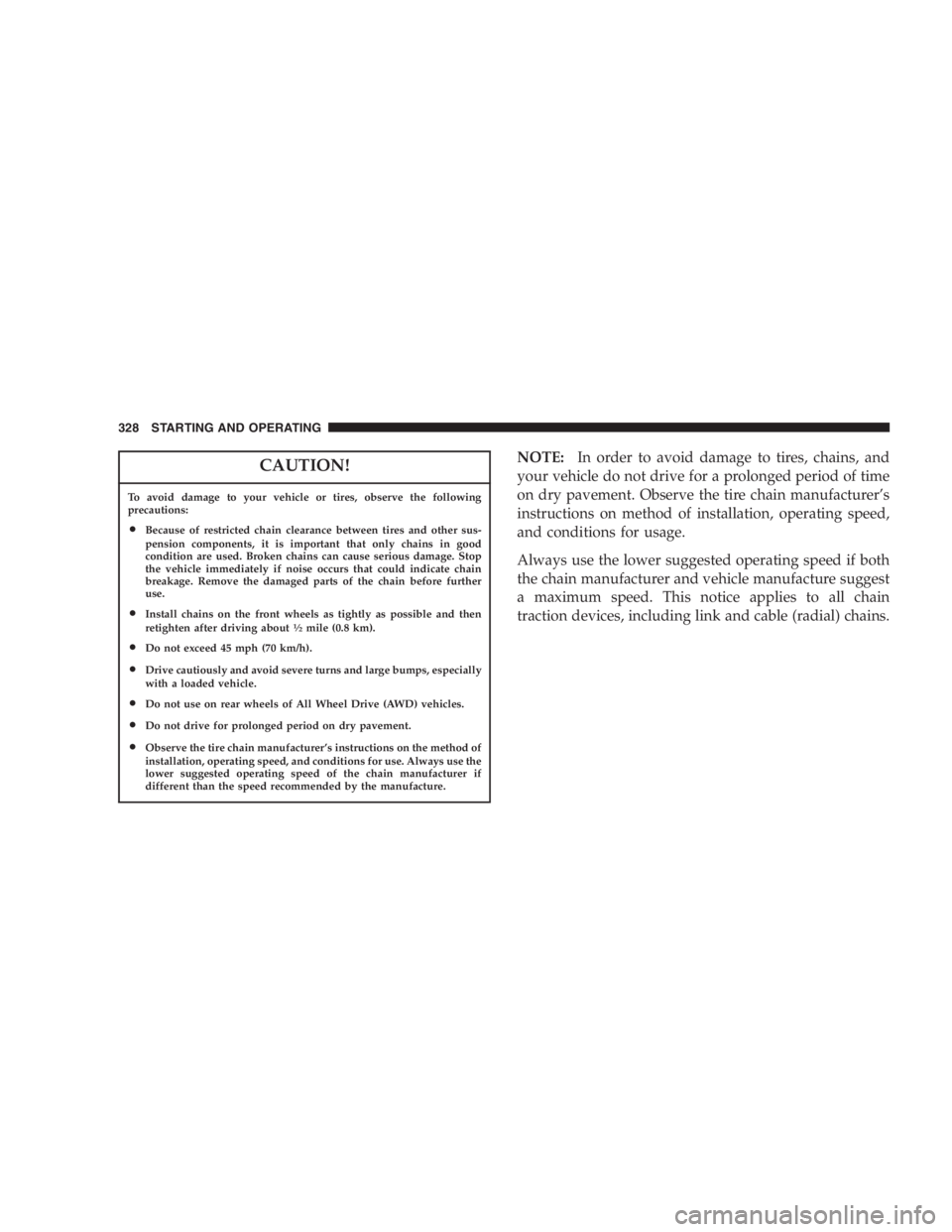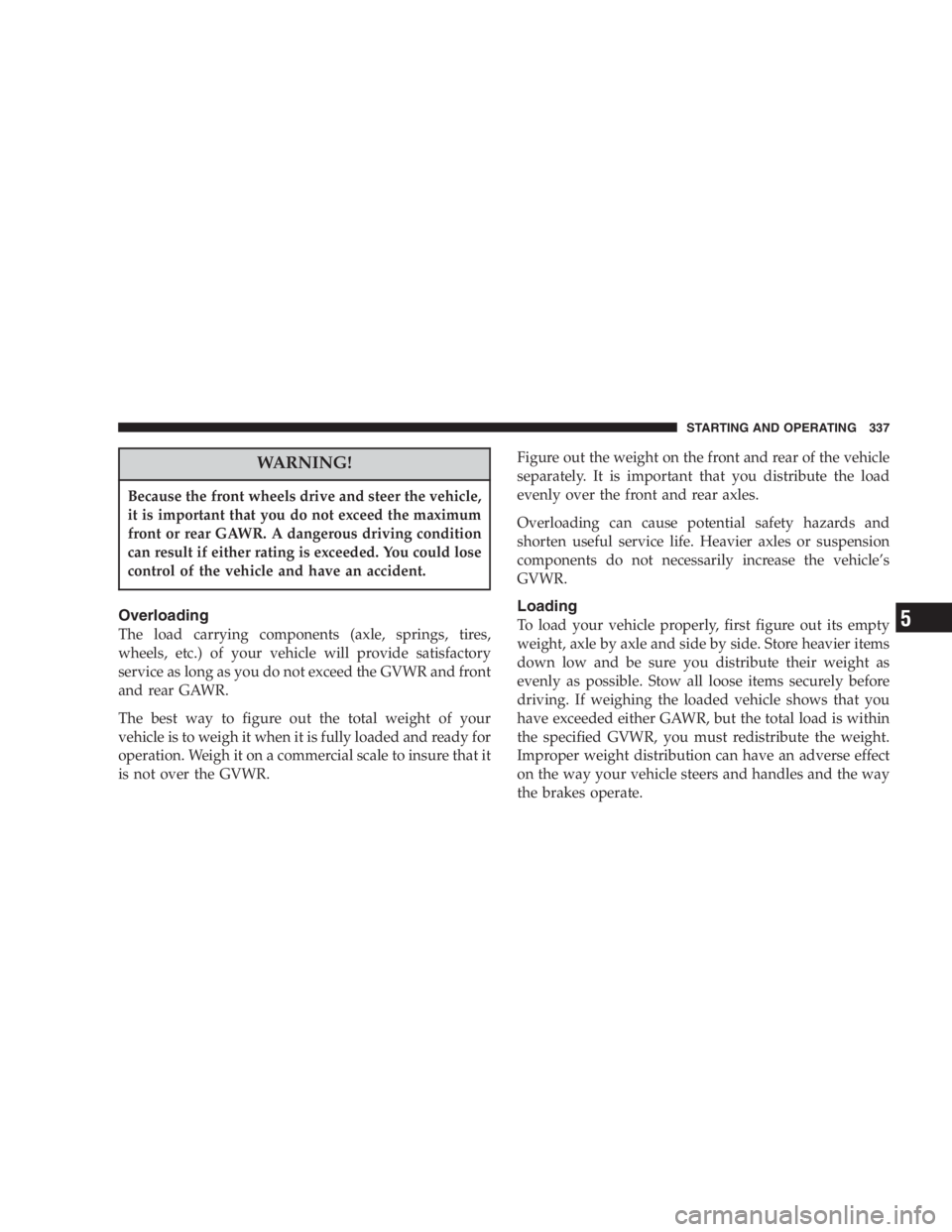Page 324 of 480

WARNING!• Do not use a tire, wheel size or rating other than that
specified for your vehicle. Some combinations of
unapproved tires and wheels may change suspen-
sion dimensions and performance characteristics,
resulting in changes to steering, handling, and brak-
ing of your vehicle. This can cause unpredictable
handling and stress to steering and suspension com-
ponents. You could lose control and have an accident
resulting in serious injury or death. Use only the tire
and wheel sizes with load ratings approved for your
vehicle.
• Never use a tire with a smaller load index or capacity,
other than what was originally equipped on your
vehicle. Using a tire with a smaller load index could
result in tire overloading and failure. You could lose
control and have an accident.
• Failure to equip your vehicle with tires having
adequate speed capability can result in sudden tire
failure and loss of vehicle control. CAUTION!Replacing original tires with tires of a different size
may result in false speedometer and odometer read-
ings.
Alignment And Balance
Poor suspension alignment may result in:
• Fast tire wear.
• Uneven tire wear, such as feathering and one-sided
wear.
• Vehicle pull to right or left.
Tires may also cause the vehicle to pull to the left or right.
Alignment will not correct this condition. See your dealer
for proper diagnosis.324 STARTING AND OPERATING
Page 325 of 480

Improper alignment will not cause vehicle vibration.
Vibration may be a result of tire and wheel out-of-
balance. Proper balancing will reduce vibration and
avoid tire cupping and spotty wear.
TIRE PRESSURE MONITOR SYSTEM — IF
EQUIPPED
The Tire Pressure Monitor System (TPM) system uses
wireless technology with wheel rim mounted electronic
sensors to monitor tire pressure levels (EXCLUDING
THE SPARE TIRE). Sensors, mounted to each wheel as
part of the valve stem, transmit tire pressure readings to
a receiver located in the instrument panel.
NOTE: The tire pressure monitoring system on your
vehicle will warn you when one of your tires is signifi-
cantly underinflated and when some combinations of
your tires are significantly underinflated. It is particularly
important, therefore, for you to check the tire pressure in
all of your tires regularly and maintain proper pressure. 1,2,3, OR 4 TIRE(S) LOW PRESSURE
Low tire pressure levels of 28 psi [1.9 bars] (193 kPa) or
less detected in one or more tires.
Inspect all tires for proper inflation pressure, once proper
tire pressure has been set the TPM system warning will
reset automatically once ignition switch has been turned
ON.
1,2,3, OR 4 TIRE(S) HIGH PRESSURE
High tire pressure levels of 48 psi [3.3 bars] (330 kPa) or
more detected in one or more tires.
Inspect all tires for proper inflation pressure, once proper
tire pressure has been set the TPM system warning will
reset automatically once ignition switch has been turned
ON. STARTING AND OPERATING 325
5
Page 326 of 480

CHECK TPM SYSTEM
The Tire Pressure Monitor System (TPM) system requires
service.
See your authorized dealer for service.
CAUTION!The TPM system has been optimized for the original
equipment tires and wheels. TPM system pressures
have been established for the tire size equipped on
your vehicle. Undesirable operation or sensor dam-
age may result when using replacement equipment
that is not of the same size, type, and/or style.
After-market wheels can cause sensor damage. Do
not use tire sealant or balance beads if your vehicle
is equipped with TPM system as damage to the
sensors may result. NOTE:
• The TPM system can inform the driver of a low tire
pressure condition of 28 psi [1.9 bars] (193 kPa) or less,
or high a tire pressure condition of 48 psi [3.3 bars]
(330 kPa) or more.
• The TPM system is not intended to replace normal tire
care and maintenance, nor to provide warning of a tire
failure or condition.
• The TPM system should not be used as a tire pressure
gauge while adjusting your tire pressure.
CAUTION!After inspecting or adjusting the tire pressure al-
ways reinstall the valve stem cap. This will prevent
moisture and dirt entry into the valve stem, which
could damage the wheel rim sensor.326 STARTING AND OPERATING
Page 328 of 480

CAUTION!To avoid damage to your vehicle or tires, observe the following
precautions:
• Because of restricted chain clearance between tires and other sus-
pension components, it is important that only chains in good
condition are used. Broken chains can cause serious damage. Stop
the vehicle immediately if noise occurs that could indicate chain
breakage. Remove the damaged parts of the chain before further
use.
• Install chains on the front wheels as tightly as possible and then
retighten after driving about 1
⁄ 2
mile (0.8 km).
• Do not exceed 45 mph (70 km/h).
• Drive cautiously and avoid severe turns and large bumps, especially
with a loaded vehicle.
• Do not use on rear wheels of All Wheel Drive (AWD) vehicles.
• Do not drive for prolonged period on dry pavement.
• Observe the tire chain manufacturer ’ s instructions on the method of
installation, operating speed, and conditions for use. Always use the
lower suggested operating speed of the chain manufacturer if
different than the speed recommended by the manufacture. NOTE: In order to avoid damage to tires, chains, and
your vehicle do not drive for a prolonged period of time
on dry pavement. Observe the tire chain manufacturer ’ s
instructions on method of installation, operating speed,
and conditions for usage.
Always use the lower suggested operating speed if both
the chain manufacturer and vehicle manufacture suggest
a maximum speed. This notice applies to all chain
traction devices, including link and cable (radial) chains.328 STARTING AND OPERATING
Page 337 of 480

WARNING!Because the front wheels drive and steer the vehicle,
it is important that you do not exceed the maximum
front or rear GAWR. A dangerous driving condition
can result if either rating is exceeded. You could lose
control of the vehicle and have an accident.
Overloading
The load carrying components (axle, springs, tires,
wheels, etc.) of your vehicle will provide satisfactory
service as long as you do not exceed the GVWR and front
and rear GAWR.
The best way to figure out the total weight of your
vehicle is to weigh it when it is fully loaded and ready for
operation. Weigh it on a commercial scale to insure that it
is not over the GVWR. Figure out the weight on the front and rear of the vehicle
separately. It is important that you distribute the load
evenly over the front and rear axles.
Overloading can cause potential safety hazards and
shorten useful service life. Heavier axles or suspension
components do not necessarily increase the vehicle ’ s
GVWR.
Loading
To load your vehicle properly, first figure out its empty
weight, axle by axle and side by side. Store heavier items
down low and be sure you distribute their weight as
evenly as possible. Stow all loose items securely before
driving. If weighing the loaded vehicle shows that you
have exceeded either GAWR, but the total load is within
the specified GVWR, you must redistribute the weight.
Improper weight distribution can have an adverse effect
on the way your vehicle steers and handles and the way
the brakes operate. STARTING AND OPERATING 337
5
Page 343 of 480
WHAT TO DO IN EMERGENCIESCONTENTS � Hazard Warning Flasher ..................344
� If Your Engine Overheats .................345
� Jacking And Tire Changing ................346
▫ Jacking Instructions — Fold-In-Floor Seating . . 347
▫ Jacking Instructions — Non Fold-In-Floor
Seating .............................359
� Jump-Starting Procedures If Battery Is Low ....365
� Driving On Slippery Surfaces ..............367
▫ Acceleration .........................367 ▫ Traction ............................367
� Freeing A Stuck Vehicle ..................368
� Towing A Disabled Vehicle ................369
▫ With Ignition Key .....................369
▫ Without The Ignition Key ...............370
▫ Towing This Vehicle Behind Another Vehicle
(Flat Towing With All Four Wheels On The
Ground) ............................370
▫ Towing This Vehicle Behind Another Vehicle
With A Tow Dolley ....................370
6
Page 347 of 480
Jacking Instructions — Fold-in-Floor Seating
Preparations For Jacking
Park the vehicle on a firm level surface, avoid ice or
slippery areas, set the parking brake and place the gear
selector in PARK. Turn OFF the ignition.
WARNING!Do not attempt to change a tire on the side of the
vehicle close to moving traffic. Pull far enough off
the road to avoid the danger of being hit when
operating the jack or changing the wheel. • Turn on the Hazard Warning Flasher.
• Block both the front and rear
of the wheel diagonally oppo-
site the jacking position. For
example, if changing the right
front tire, block the left rear
wheel.
• Passengers should not remain in the vehicle when the
vehicle is being jacked. WHAT TO DO IN EMERGENCIES 347
6
Page 350 of 480
Jacking Instructions — Fold-in-Floor Seating
1. Loosen (but do not remove) the wheel lug nuts by
turning them to the left one turn while the wheel is still
on the ground.
2. To remove the compact spare tire/cover assembly,
assemble the winch handle extensions to form a “ T ’ and
fit the winch “ T ” handle over the drive nut. Rotate the
nut to the left approximately 33 turns until the winch
mechanism stops turning freely, this will allow enough
slack in the cable to allow you to pull the spare tire out
from under the vehicle. Spare Tire Removal350 WHAT TO DO IN EMERGENCIES